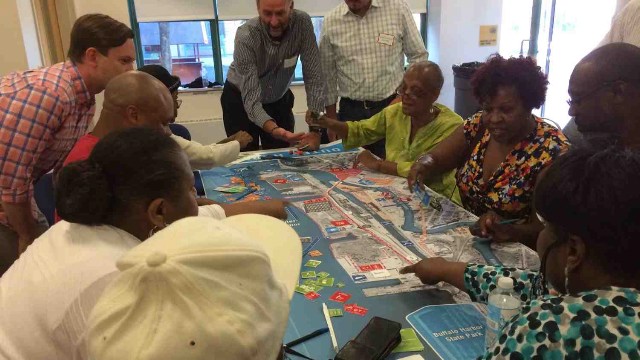Perkins+Will announced on Aug. 18 the firm’s latest planning wins and expanded business for its planning practice, with a focus on work for underserved neighborhoods and regions.
Led by global leaders Janice Barnes and Karen Alschuler, Perkins+Will has broadened its efforts with economic development groups, regional planning agencies, as well as transit agencies, healthcare providers, and mixed-use developers. The work is resulting in comprehensive, long-term plans that will guide new growth in places like Buffalo, N.Y., Kingston, R.I., and Brooklyn, N.Y.
“These new projects reflect Perkins+Will’s commitment to the many New York communities where serious need remains for improved community health and its supporting infrastructure, housing, health services, recreation, and transit,” says Barnes, PhD. “It’s all part of public- and private-sector efforts to knit together the very fabric of our cities, to reinforce and revitalize them, which can only happen through serious community engagement.”
Helping connect community leaders with planning agencies and such client groups as New York’s Economic Development Corp. (EDC), the Erie Canal Harbor Development Corp. (ECHDC), Wyckoff Heights Medical Center, and Community Care of Brooklyn PPS, Perkins+Will is taking a leadership role in shaping major waterfront redevelopment, urban revitalization, transit centers and health districts, says Barnes.
Principals include Barnes, who leads the firm’s Planning+Strategies group, along with: Karen Alschuler, who leads Urban Design; Robin Guenther, FAIA, a global leader in resilience and healthcare; and health district expert Jason Harper, AIA, who recently presented on health district planning in Toronto at the World Congress on Design & Health.
In addition, Perkins+Will has been selected as lead consultant for a number of significant planning commissions and related initiatives. Recently announced projects led by Perkins+Will include:
Buffalo
Perkins+Will has been selected to design a waterfront master plan in Buffalo, including the reuse and redevelopment of 171 acres of the outer Lake Erie harbor. The plan will reconnect downtown Buffalo with its waterfront and create a vibrant destination of community, commerce and culture. The client, ECHDC, is working with the firm’s New York and San Francisco offices on three development alternatives for the land, with significant community engagement and public participation. Led by Alschuler and Dennis Dornan, a senior planner in the firm’s urban design group, the result will be a complete land-use framework, including financial projections and an operations plan, to encourage active use of the outer harbor while enhancing public access and linking it to downtown and its Canalside district. Thomas Dee, the CEO of ECHDC, noted that Perkins+Will has a track record of successful experience with cold-weather waterfronts – in Ottawa and Toronto, among others.
The firm is also involved with projects that address legacy brownfield remediation to reimagine post-industrial sites, such as their new project in Kingston, N.Y. The firm’s senior planner, Amy Thompson, notes that this work reflects Perkins+Will’s long history of leadership in urban design and environmental stewardship nationally.
Health Districts
The firm is also working on a range of planning projects where the goal is to create a regional health district – a livable, walkable neighborhood that focuses on wellness, prevention and overall community health through network partnering and pooled resources. Perkins+Will’s Harper, who frequently lectures and publishes on the topic, has also worked to advance urban design and planning criteria for health districts with ULI, the Congress for New Urbanism, EcoDistricts, AIANY, the New York Academy of Medicine, and other groups. Harper, along with Basak Allen and David Green, advocates from both the grassroots and global perspective in his efforts to create healthier communities.
Brooklyn
One of those budding health districts may soon be in Brooklyn, where Barnes recently chaired a ULI workshop to spark new implementation strategies for a transit-oriented development (TOD) zone called Broadway Junction. Barnes and Harper, along with Daniel Windsor, senior urban planner at Perkins+Will, recently partnered with a panel of experts and community leaders to identify the short-, mid- and long-term “enabling projects” for the Broadway Junction community, The ULI New York's Technical Assistance Panel, or TAP, is a volunteer effort to provide urban planning strategies for targeted communities. The Broadway Junction community is within the catchment area of Wyckoff Heights Medical Center, where Perkins+Will is also at work assisting the medical center on the development of a strategy for a “health improvement district.”
The TAP will make recommendations to the New York City Department of City Planning as well as to local community board and nonprofits, “to incentivize large-scale and mixed-use development along key blocks … and create new employment, retail, and entertainment opportunities for surrounding residential communities,” says ULI New York. In parallel, and guided by Perkins+Will’s efforts, Wyckoff is identifying opportunities to partner with healthcare providers in the Broadway Junction community as well as in their larger catchment area, to increase access to healthcare services for this underserved area, which has some of the highest asthma and diabetes rates in the city.
Transit Oriented Developments of TODs (various locations)
In addition to Broadway Junction, Perkins+Will planners have been engaged for other large, mixed-use TOD plans in North America to spur economic revitalization in dozens of underserved communities. Recent TOD projects by the firm include the award-winning Treasure Island Master Plan + Urban Design project in San Francisco, the Beltline Corridor Design in Atlanta, and Station Park Green in San Mateo, Calif.
Resiliency (various locations)
Perkins+Will has worked with national, state and city leaders on regional plans and facility specific planning, design, and construction projects to identify and implements techniques for reducing climate- and weather-related risks to communities and the built environment. These planning and architecture projects examined how underserved communities can become more resilient to – and recover more swiftly from – the disastrous impacts of future severe weather events. Guenther, one of the firm’s experts on resilience, helps prepare health organizations for increased climate risks and severe weather. Guenther will speak on the topic at the conference“Building the Resilient City,” to be held Sept. 4-5 in San Francisco by the Urban Land Institute (ULI).
Related Stories
| Dec 16, 2013
Helene Combs Dreiling, FAIA, inaugurated 2014 AIA President
Helene Combs Dreiling, FAIA, executive director of the Virginia Center for Architecture, was inaugurated as the 90th president of the American Institute of Architects (AIA) during ceremonies held on December 12th at the Andrew W. Mellon Auditorium. She succeeds Mickey Jacob, FAIA, in representing nearly 83,000 AIA members.
| Dec 13, 2013
GRW acquires West Virginia design firm Chapman Technical Group
GRW is expanding its capabilities through the recent acquisition of Chapman Technical Group, a 36-person West Virginia-based firm.
| Dec 13, 2013
AIA, MIT issue joint report on impact of design on public health
The research looks at the health of eight U.S. cities and lays out a path for translating the research into meaningful findings for policy makers and urban planners.
| Dec 11, 2013
Wyndham unveils hotel prototype for its Hawthorn Suites chain
The extended-stay hotel prototype reduces development costs by 46% for franchisees and enhances the overall guest experience.
| Dec 10, 2013
16 great solutions for architects, engineers, and contractors
From a crowd-funded smart shovel to a why-didn’t-someone-do-this-sooner scheme for managing traffic in public restrooms, these ideas are noteworthy for creative problem-solving. Here are some of the most intriguing innovations the BD+C community has brought to our attention this year.
| Dec 9, 2013
Tips for designing higher education's newest building type: the learning commons
In this era of scaled-down budgets, maximized efficiencies, new learning methods and social media’s domination of face time, college and university campuses are gravitating toward a new space type: the learning commons.
| Dec 9, 2013
Does technology help or hinder innovation?
Whether digital technology will help or hinder workplace insights remains a topic of ongoing debate. FastCo.Design features insights from business scholars on both sides of the issue.
| Dec 6, 2013
French concert hall includes integrated musical elements [VIDEO]
La Métaphone, a concert hall in Ognies, France, is a 1,980-sm facility with the unique characteristic of being a structural musical instrument. The solar-powered building incorporates musical elements in its walls, which can be played by musicians inside or outside the facility.
| Dec 6, 2013
Goettsch Partners selected 2013 AIA Chicago Firm of the Year
Architecture firm Goettsch Partners (GP) has been named the 2013 Firm of the Year, as conferred by the Chicago chapter of the American Institute of Architects (AIA Chicago). The award is the highest honor a firm can receive from the chapter.
| Dec 5, 2013
Maximizing the impact of online marketing
Because most professional services firms exist to help their clients reduce risk and navigate an uncertain future, they tend to approach the world of online or digital marketing with some caution. Here are four tips for maximizing the impact of online marketing.
















